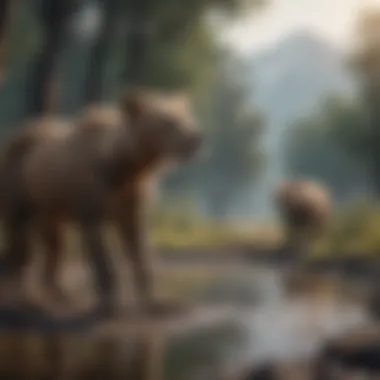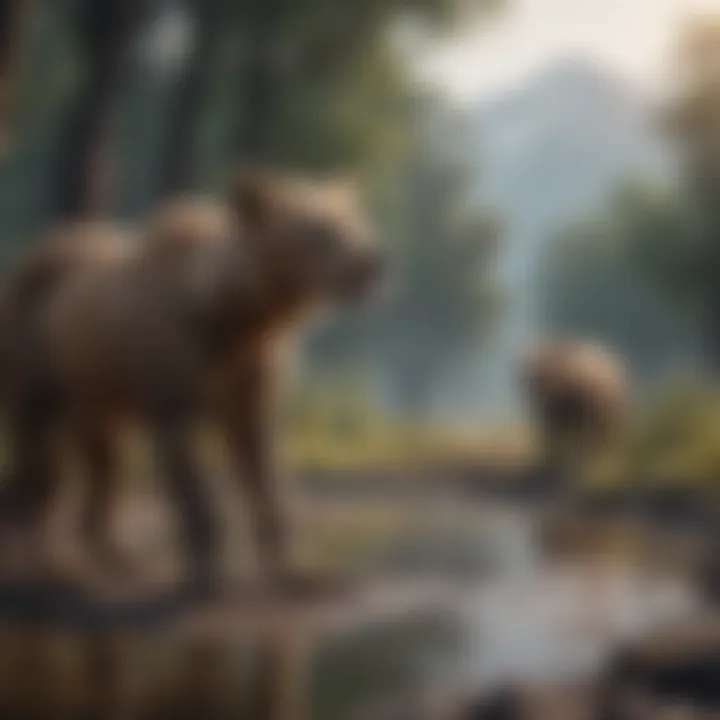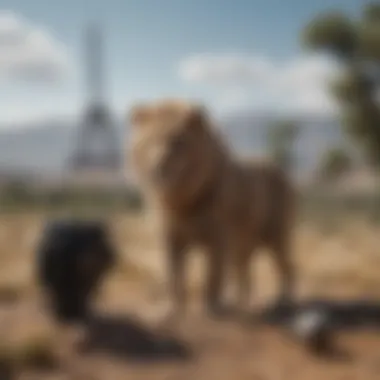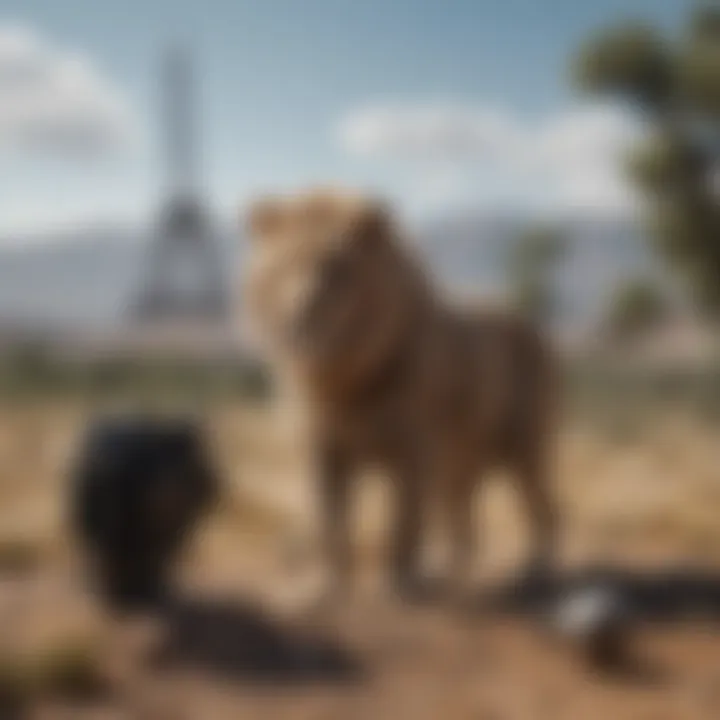Understanding Animal Extinction: Causes and Solutions


Intro
The issue of animal extinction is pressing and complex. The loss of species threatens ecosystems and impacts human life worldwide. Various factors contribute to this crisis, from human activities to natural processes. Understanding these causes helps us develop effective responses.
Recognizing the interconnectedness of all life is fundamental. Biodiversity plays a vital role in maintaining ecological balance. With ongoing habitat destruction, climate change, and poaching, the challenge of extinction grows ever more urgent.
In this discourse, we will examine the causes, impacts, and possible solutions to animal extinction. By doing so, we aim to foster a deeper understanding of the necessity for global action and collaboration in conservation efforts.
Preamble to Animal Extinction
Animal extinction is a pressing issue that affects not only the natural world but also human existence. The importance of understanding this topic lies in the intricate relationships between species and their habitats. As species decline or disappear, the balance of ecosystems becomes disrupted. This disruption leads to broader consequences that impact biodiversity, which is vital for sustaining our environment. Moreover, the loss of species can undermine resources necessary for human survival, such as clean air, water, and food.
Understanding animal extinction involves grasping the multiple factors that contribute to it. These factors include human-driven habitat destruction, climate change, poaching, and the introduction of invasive species. Each of these elements plays a role in diminishing wildlife populations. By delving into these causes, we can appreciate the urgency of addressing animal extinction and its far-reaching effects.
As we explore the various dimensions of this topic, we will consider the historical context of extinction events. Learning from past experiences enhances our ability to respond effectively. It also empowers individuals and communities to support conservation efforts and legislative measures aimed at protecting threatened species. Therefore, a comprehensive approach to the problem of animal extinction is essential now more than ever.
Definition of Extinction
Extinction refers to the permanent loss of a species from the Earth. When a species is declared extinct, it means there are no longer any living individuals of that species left. This can happen for several reasons. Habitat loss, environmental changes, or inability to adapt to new conditions all contribute to the phenomenon.
The concept of extinction is not new. It can be traced back throughout history, with natural extinction occurring over millions of years. However, human actions have accelerated the pace of extinction significantly in recent decades. As the global population increases, so does the pressure on land, resources, and wildlife.
Historical Perspective on Extinction
Historically, extinction has affected many species, often linked to human development. In prehistoric times, early humans hunted large animals, which likely contributed to the extinction of various megafauna. Examples include woolly mammoths and saber-toothed cats. These early events showcase that human activity has been influencing extinction long before contemporary issues arose.
As civilization progressed, habitat destruction became more prevalent due to agriculture, urbanization, and industrial activities. The Great Auk, a flightless bird that existed in the North Atlantic, was hunted to extinction in the mid-19th century. This case exemplifies how human exploitation can lead to irreversible loss.
Understanding these historical perspectives allows us to recognize patterns that continue today. It illustrates the ongoing need for informed conservation strategies and raises awareness of the consequences of inaction in the face of extinction.
Current Extinction Rates
Understanding current extinction rates is crucial to recognizing the severity and immediacy of the biodiversity crisis facing our planet. The present situation reveals alarming rates of species loss, which serves as a clear indicator of ecological health and balance. Tracking these rates allows researchers, policymakers, and the public to gauge the efficacy of conservation efforts and to strategize accordingly. By examining extinction statistics, we can better comprehend the ongoing threats to various species and their habitats.
Global Extinction Statistics
Recent reports, including data from the International Union for Conservation of Nature (IUCN), indicate that nearly one million species are at risk of extinction. This figure represents a sobering reality where species are disappearing at rates 100 to 1,000 times higher than the natural background rates of extinction. These statistics highlight a global trend that far exceeds historical occurrences and emphasizes the human influences that contribute to these dire outcomes.
Factors such as habitat loss, climate change, and human encroachments play a significant role in the escalating extinction rates. Monitoring these statistics not only reflects the immediacy of the threat but also aids in targeted intervention strategies. It becomes apparent that without concerted action, certain species may soon be lost forever.
Species at Risk
Species categorized as at risk of extinction can be divided into various levels of urgency, including endangered and critically endangered species. Each classification reflects the degree of threat facing these organisms and serves to underscore the necessity of protection measures.
Endangered Species
Endangered species are defined as those whose population sizes have dwindled to critical levels. This classification signifies that these species are facing a high risk of extinction in the wild. For example, the Amur leopard and the Sumatran orangutan fall into this category.
The key characteristic of endangered species is their reduced population size and limited geographic range, which renders them particularly vulnerable to environmental changes and human activities. Recognizing endangered species is essential for prioritizing conservation initiatives. They typically benefit from focused attention, as their preservation is often seen as indicative of broader ecological health.
On the downside, the plight of endangered species often leads to increased efforts from organizations and governments, which can at times be met with challenges such as insufficient funding or improper implementation of protective laws.
Critically Endangered Species
Critically endangered species face an even more imminent threat, with populations often reduced to fewer than 250 mature individuals. The Vaquita, a small porpoise found in the northern part of the Gulf of California, stands as an example of a critically endangered species.
These species are marked by their precarious status, where every individual counts significantly against the backdrop of extinction. The critical aspect of these species draws urgent action from conservation groups and legislative measures aimed to prevent total loss. However, challenges remain, as efforts must contend with illegal trafficking and habitat destruction.
Higher public awareness and advocacy are essential to promote conservation for these species, ensuring their recovery before it is too late.
"The extinction of even a single species can have cascading effects within an ecosystem, amplifying the risks of further biodiversity loss."


By understanding the classifications and implications surrounding endangered and critically endangered species, stakeholders can create more targeted and effective strategies to address the ongoing biodiversity crisis.
Major Causes of Animal Extinction
Understanding the major causes of animal extinction is essential for addressing the ongoing loss of biodiversity. By recognizing these factors, we can take informed action to mitigate their impact. Each cause contributes to a broader challenge that threatens not just individual species, but entire ecosystems. This section explores four primary drivers of extinction, namely habitat destruction, climate change, poaching, and invasive species. These are interlinked as they often exacerbate one another, making solutions even more complex.
Habitat Destruction
Urbanization
Urbanization refers to the increase in population in urban areas leading to the expansion of cities. This process leads to the conversion of natural habitats into residential, commercial, and industrial spaces. The key characteristic of urbanization is its rapid pace, driven by human migration and economic development. This expansion often fragments ecosystems, isolating wildlife and diminishing available habitats. As cities grow, they encroach on the territories that many species rely on for survival. The unique feature of urbanization is its dual role as both a driver for economic growth and a serious threat to species. While urban areas can offer development and improved living conditions, they also result in significant habitat loss.
Deforestation
Deforestation involves the clearing of forests for agriculture, logging, or urban development. This activity greatly contributes to habitat destruction, as it removes trees that are critical for many species. One key characteristic of deforestation is its scale; large areas are often cleared at once, leading to significant habitat reduction. Moreover, deforestation exacerbates climate change by releasing carbon stored in trees. The unique feature of this process is its immediate and long-term effects on wildlife. In the short term, it can cause species displacement. Long term, it leads to decreased biodiversity and disrupts the ecosystem services that forests provide.
Climate Impact
Climate impact refers to the changes in climate patterns due to human activities such as fossil fuel burning and industrial processes. This key characteristic is central to understanding how shifting weather patterns create unsuitable conditions for many animals. It can lead to more extreme weather events, altered food availability, and changes in breeding cycles. Its unique feature is that it does not affect all species equally; some adapt while others face extreme challenges leading to possible extinction. Climate impact largely mimics the effects of habitat destruction by making current habitats untenable for many species.
Climate Change
Global Warming
Global warming is primarily caused by the greenhouse gases released from human activity, leading to a rise in global temperatures. This issue affects animal extinction broadly as it impacts breeding, migration, and habitat conditions. The key characteristic of global warming is its extensive reach; it influences weather patterns across the globe. This aspect makes it a significant focus for conservation. The unique feature of global warming is its potential to create feedback loops that worsen environmental conditions over time. Increasing temperatures can lead to habitat loss, altered ecosystems, and changes to food availability, which compounds the extinction crisis.
Changing Ecosystems
Changing ecosystems refer to the shifts in ecological communities caused by climate change. Such changes can lead to the decline of certain species while allowing others to thrive. The key characteristic of this phenomenon is the unpredictability of how ecosystems will adjust. Some species may adapt, while many cannot, leading to a loss of biodiversity. This aspect underscores the complexity of habitats. The unique feature of changing ecosystems is their potential rapid evolution or collapse. This makes the study of ecosystems vital as minor changes can cascade into wider ecological impacts that threaten numerous species.
Poaching and Illegal Wildlife Trade
Target Species
Target species refer to those animals that are most often hunted or captured for illegal trade. Specific species are coveted for their body parts, which can be sold for various purposes. The key characteristic of these target species is that they often include those already at risk due to other factors, such as habitat loss. This makes them particularly vulnerable. The unique feature of target species is their combined threat; poaching removes individuals from populations, further lowering reproductive rates and increasing extinction chances. This aspect highlights the urgency in addressing illegal wildlife trade.
Impact on Ecosystems
The impact of poaching extends beyond individual species to entire ecosystems. Removing specific animals can destabilize food webs and disrupt ecological balance. The key characteristic here is the interconnectedness of species within their habitats. This makes the collapse of one species detrimental to others. The unique feature of this impact is the potential for an ecological domino effect, where the loss of one species leads to a cascade of additional losses. Recognizing this interconnectedness is vital to understand fully how human actions affect biodiversity.
Invasive Species
Invasive species are non-native organisms that can disrupt local ecosystems. They often outcompete native species for resources, leading to declines in native populations. The key characteristic of invasive species is their ability to reproduce and adapt rapidly. This adaptability allows them to thrive in new environments, pushing out species that are not as resilient. The unique feature of invasive species is their role as a catalyst for further decline in biodiversity. They illustrate the complexities of conservation efforts; focusing on native species alone is insufficient if invasive populations are not managed effectively.
Ecological Impacts of Animal Extinction
The ecological impacts of animal extinction represent a critical area of concern in the discussion of biodiversity. The loss of various species alters ecosystems in profound ways, often leading to ecological collapse. Each species plays a specific role within its habitat, and when a species disappears, it can set off a chain reaction affecting other organisms. The health and stability of ecosystems are contingent upon the interplay of different species, and extinction disrupts this intricate balance.
Loss of Biodiversity
Biodiversity refers to the variety of life on Earth. It includes the variety of species, genetic diversity, and diversity of ecosystems. The loss of biodiversity is one of the main consequences of animal extinction. This loss impacts ecological resilience—the ability of ecosystems to absorb changes and return to their original state.
When biodiversity is compromised, ecosystems become less stable. They may struggle to cope with environmental changes, diseases, and invasive species. Research indicates that greater biodiversity correlates with ecosystem resilience. Protecting biodiversity is essential for maintaining the services ecosystems provide.
Disruption of Ecosystem Services
Ecosystem services are natural processes that benefit humans and the environment. These services include pollination, water purification, and climate regulation. When animal species become extinct, the disruption of these services may have dire consequences.
Pollination
Pollination is a vital process that supports global agriculture and ecosystems. Many plants, including crops and wild flora, rely on animals like bees, birds, and bats for pollination. The decline of these pollinators can threaten food security.


A key characteristic of pollination is its role in promoting genetic diversity among plants. This genetic diversity is essential for adapting to changing environments. The absence of specific pollinators can lead to reduced plant populations, affecting entire ecosystems. Maintaining diverse pollinator populations is critical for the sustainability of agricultural systems and natural landscapes.
Water Purification
Water purification is another essential ecosystem service. Various species contribute to filtering and cleaning water, ensuring that it is safe for humans and wildlife. For example, wetland ecosystems rely on certain animal species to maintain water quality. The extinction of these species can lead to the degradation of water sources.
The proven ability of natural systems to filter pollutants and nutrients highlights the importance of these animals in maintaining water quality. Further, healthy water ecosystems support numerous forms of life. The loss of diverse animal species threatens the intricate web of interactions that sustain clean water.
Societal Consequences of Extinction
The societal consequences of animal extinction are profound and multifaceted. Understanding these implications is crucial for informing conservation strategies and public policy. The extinction of species affects not just the natural world but also human communities and economies. As loss of biodiversity escalates, so does the potential for significant disruptions in ecosystem services that are vital for human survival.
Economic Implications
Tourism
Tourism represents one of the largest industries that can be directly linked to biodiversity. Wildlife tourism, in particular, attracts millions of visitors worldwide, contributing billions in revenue. The presence of diverse species enhances the attractiveness of natural areas, thus supporting local economies. The key characteristic of tourism in this context is its interdependence with wildlife. When species face extinction, tourism destinations become less appealing, leading to potential economic downturns in regions reliant on such activities.
Moreover, the shift from traditional tourism to more sustainable practices is gaining traction. Ecotourism, which promotes responsible travel to natural areas, enables visitors to engage with wildlife while contributing to conservation efforts. This unique feature of ecotourism underscores the dual benefit of protecting species and ensuring economic stability for local communities. However, there are disadvantages as well, such as the risk of tourism itself causing harm to fragile ecosystems, if not managed properly.
Sustainable Practices
Sustainable practices in the economy focus on utilizing resources in a way that meets present needs without compromising future generations. These practices are increasingly important in the context of animal extinction. A significant aspect of sustainable practices is their ability to mitigate the adverse effects of human activities on ecosystems. For instance, sustainable farming techniques can reduce habitat destruction and promote biodiversity.
The hallmark of these practices is their long-term vision, prioritizing ecological balance over short-term gain. As such, they address the pressing need for resilience in both ecosystems and human economies. Unique features of sustainable practices include renewable resources and minimized waste production, which are essential for reducing the ecological footprint of human activities. However, the challenge lies in the implementation phase; sustainable practices often require upfront investments and might face resistance from industries driven by immediate profits.
Cultural Significance
The cultural significance of animals is deeply ingrained across many societies. Animals often carry symbolic meanings and play pivotal roles in traditions, folklore, and arts. When a species goes extinct, the cultural narratives attached to that species can be lost forever. In many Indigenous cultures, certain animals hold spiritual significance and are integral to their identity. The extinction of these animals can lead to a sense of loss that transcends ecological impact, affecting community cohesion and heritage.
Preserving animal species is thus not only an ecological imperative but also a cultural one. Conservation efforts that respect and incorporate cultural values can foster a sense of ownership and shared responsibility among local populations. Engaging communities in the conservation process can strengthen their connection to both the land and its wildlife, promoting a holistic approach to environmental stewardship.
"The loss of species is not just a biological crisis, but a cultural and social one as well."
In summary, the societal consequences of extinction are varied and deeply significant. From economic impacts in tourism and sustainable practices to the irreplaceable cultural losses, the need for conservation is clear. Addressing these consequences requires a comprehensive approach that combines economic viability, cultural sensitivity, and ecological integrity.
Conservation Efforts
Conservation efforts are critical in addressing the pressing issue of animal extinction. They encompass a variety of strategies aimed at protecting endangered species and preserving their habitats. Effectively, these efforts not only help sustain biodiversity, but also maintain the health of ecosystems on which human life depends. Understanding the multifaceted nature of these initiatives can provide insight into how society can combat the ongoing crisis of extinction.
Protected Areas and Reserves
Protected areas and reserves play a vital role in conservation by providing safe habitats for species that are at risk. These zones are designated to shield ecosystems from human encroachment, allowing flora and fauna to thrive without the pressures of development and pollution. They serve as sanctuaries where endangered species can breed and repopulate.
The establishment of national parks, wildlife reserves, and marine protected areas are common examples that illustrate this concept. They not only serve to protect wildlife but also can help regenerate ecosystems. However, the effectiveness of these areas depends significantly on proper management and adequate funding. Engaging local communities in conservation efforts enhances the success of these initiatives, as it fosters cooperation and respect for local biodiversity.
Legislation and Policy
Legislation and policy form the backbone of effective conservation efforts. They provide the framework necessary for protecting endangered species from exploitation and habitat destruction. Key legislative acts and international agreements set guidelines that countries must follow to mitigate the impacts of human activities on wildlife.
CITES
The Convention on International Trade in Endangered Species of Wild Fauna and Flora (CITES) is a significant global agreement aimed at ensuring that international trade in wild animals and plants does not threaten their survival. One of CITES' key characteristics is its ability to regulate trade through a system of permits. This helps prevent over-exploitation of species that are at risk.
CITES is beneficial for the article as it highlights the importance of international cooperation in wildlife conservation. However, its unique challenge lies in its reliance on member countries' compliance, which can vary significantly.
Endangered Species Act
The Endangered Species Act (ESA) is a crucial legislative framework in the United States that aims to protect species that are at risk of extinction. The ESA identifies and lists endangered species and designates critical habitats that require protection. This act is popular due to its strong legal mechanisms that empower federal authorities to take necessary actions to conserve species and their habitats.
A unique feature of the ESA is the requirement for a recovery plan for each listed species, which outlines steps needed to improve its status. However, it faces challenges such as funding limitations and political resistance, which can hinder its effectiveness.


The preservation of biodiversity is not just about protecting animals; it is about safeguarding the very fabric of our ecosystems, which ultimately sustains human life.
Challenges in Conservation
Conservation efforts face numerous obstacles that hinder effective action against the alarming rates of animal extinction. Understanding these challenges is critical for developing practical and sustainable solutions. Conservation is not merely about protecting individual species; it encompasses a broader commitment to maintaining ecological balance, which affects us all. Identifying these hurdles helps both the public and policymakers grasp the complexity of the issue and fosters a sense of urgency.
Funding Limitations
One of the most pressing challenges is the limitation of funding for conservation initiatives. Many organizations rely on donations, grants, and government support to finance their projects. However, these sources often fall short of what is actually needed. For instance, habitat restoration projects require significant investment to be successful. When budgets are tight, conservation programs risk being scaled back or abandoned entirely.
"Conservation funding often struggles to keep pace with the real costs of protecting biodiversity and restoring ecosystems."
The scarcity of funds is compounded by competing priorities in government budgets. Issues like healthcare, education, and infrastructure typically take precedence over environmental initiatives. This results in underfunded agencies, which lack the resources necessary to implement effective conservation programs.
Additionally, global economic downturns can affect philanthropic giving. When donors face financial uncertainty, their willingness to support conservation may diminish. This pattern creates a cycle where urgent conservation needs coincide with financial shortfalls.
Political and Social Barriers
Beyond financial constraints, political and social barriers significantly obstruct conservation efforts. Policymaking surrounding wildlife protection can be complicated, influenced by various interests, including economic development, agriculture, and industry. Lobbying from powerful sectors can lead to weakened environmental regulations.
Social attitudes towards conservation also play a crucial role. In some regions, communities may prioritize immediate economic benefits over long-term ecological health. For example, a community might support logging or mining in a protected area for short-term employment and revenue. This prioritization can create conflicts between conservationists advocating for wildlife habitats and local populations seeking economic opportunities.
Effective conservation requires comprehensive strategies that address these barriers. Engaging communities in conservation efforts is vital. This involvement creates a sense of shared responsibility and can transform opposition into support. It is essential to foster dialogue that aligns biological conservation with human interests, thereby making conservation a shared goal rather than an external imposition.
Future Directions in Conservation Biology
Future directions in conservation biology are becoming increasingly vital as we face a crisis of biodiversity loss. The integration of advanced methodologies and inclusive practices is crucial. With technology evolving rapidly, it brings forth new opportunities to address the pressing challenges of animal extinction. This section outlines how technological innovations and public engagement can pave the way for smarter conservation strategies.
Technological Innovations
Data Analysis
Data analysis plays a significant role in contemporary conservation efforts. The ability to collect and process large amounts of data allows researchers to gain insights into species population dynamics, habitat use, and threat assessments. One key characteristic of data analysis is its capability to incorporate vast datasets from various sources, enhancing the accuracy of models that predict extinction risks. This makes it a beneficial choice for conservationists looking to make informed decisions.
A unique feature of data analysis is its application in predictive modeling. By using algorithms, researchers can forecast future scenarios based on current data trends. This approach has advantages such as identifying species most at risk and evaluating the effectiveness of conservation actions. However, there are disadvantages too, including the need for extensive and sometimes expensive data collection, which may not always be feasible.
Remote Sensing
Remote sensing contributes significantly to conservation biology by providing detailed information about ecological systems. This technology involves the use of satellite imagery and aerial photography to monitor habitats and detect changes over time. One key characteristic of remote sensing is its ability to cover large areas, making it a practical tool for assessing biodiversity in difficult-to-reach environments.
A unique aspect of remote sensing is its capacity for real-time monitoring. This allows conservationists to react quickly to environmental changes, such as habitat loss or illegal activities like poaching. The advantages of remote sensing include cost-effectiveness and efficiency. On the downside, cloud cover and atmospheric conditions may affect data accuracy.
Public Engagement Initiatives
Public engagement initiatives are essential for sustaining conservation efforts. They involve educating communities, encouraging volunteer participation, and building local stewardship. Engaging the public fosters a sense of responsibility towards wildlife preservation. It ensures that conservation strategies are not only top-down but also community-driven.
By encouraging local involvement, these initiatives can lead to increased funding and resources as communities see the value in protecting their natural environment. Moreover, public input can provide valuable insights into local ecological knowledge, enhancing the overall effectiveness of conservation efforts. The future of conservation biology hinges on these collaborative relationships between scientists and the public.
Finale
The topic of animal extinction serves as a crucial reminder of the fragile relationship between humanity and nature. As society progresses, the implications of species loss become increasingly apparent. The significance of this conclusion lies in three key areas: understanding the urgency, recognizing the interconnectedness of ecosystems, and promoting informed action.
Summary of Key Points
In reflecting on the contents of this article, several vital points emerge:
- Definition of Extinction: Understanding what extinction means is foundational. It goes beyond the simple disappearance of a species; it embodies a loss of biodiversity that can destabilize entire ecosystems.
- Current Extinction Rates: Species are disappearing at an alarming rate, with numerous plants and animals facing imminent threats. Current statistics underscore the gravity of this crisis.
- Major Causes: Habitat destruction, climate change, poaching, and invasive species are primary drivers of extinction. Addressing these issues requires immediate attention and concerted effort.
- Ecological and Societal Impacts: The effects of losing species extend beyond nature into economics and culture, influencing everything from tourism to traditional practices.
- Conservation Efforts and Challenges: Despite various initiatives, conservation faces numerous challenges such as funding limitations and political hurdles, complicating the task of safeguarding biodiversity.
- Future Directions: Innovations in technology and public engagement are promising avenues for enhancing conservation efforts and ensuring species survival.
Call to Action for Conservation
Awareness is merely the first step.
A call to action is essential for anyone who is concerned about the state of our natural world. This involves:
- Support: Back local and global conservation organizations. Entities like the World Wildlife Fund and The Nature Conservancy work tirelessly to protect threatened species.
- Advocacy: Engage with policymakers to create and enforce environmental protection laws. Policies like the Endangered Species Act are only effective when supported by public will.
- Education: Sharing information about the importance of biodiversity and the impacts of extinction can foster a more informed public. Schools and community groups can play pivotal roles in this process.
- Personal Action: Individuals can contribute by making environmentally responsible choices, such as reducing plastic use, practicing sustainable consumption, and supporting eco-friendly companies.
The loss of animal species is not just an ecological issue; it is a reflection of human choices and priorities. By acknowledging our role in this crisis and taking proactive measures, we can work toward a future where biodiversity flourishes rather than diminishes.







